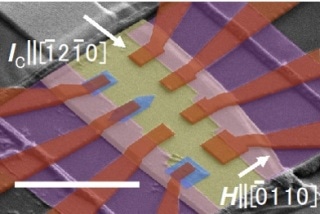Mar 7 2019
All electronic devices are powered by electric currents. The aim of the emerging field of spintronics is to replace electric currents with the so-called spin currents. At present, scientists at the University of Tokyo have achieved a major advancement in this field.
 University of Tokyo researchers created sample devices to aid future researchers explore potential applications. (Image credit: The Institute for Solid State Physics)
University of Tokyo researchers created sample devices to aid future researchers explore potential applications. (Image credit: The Institute for Solid State Physics)
The magnetic spin Hall effect that they discovered could result in high-speed, low-power, and high-capacity devices. They have developed sample devices, which can further investigate possible applications.
Electricity lit up the world and electronics connected it. Spintronics will be the next step forward in this procession and we can only imagine what advances it may bring.
Yoshichika Otani, Professor, Institute for Solid State Physics.
So what exactly spintronics means and why should researchers be excited?
“In essence spintronics is used to transfer information, something we have always used electric currents for,” adds Otani, “but spintronics offers a whole range of advantages, some of which we’re just starting to understand.”
At present, the power efficiency of electronic and electrical devices is a confining factor in technological advancement. The challenge is in the nature of electric currents, the flow of charge in the form of electrons. When electrons move through a circuit, they tend to lose a specific amount of energy as waste heat. Spintronics enhances upon this condition—rather than exploiting the movement it uses another property of the electrons for information transfer, their angular momentum or “spin.”
In spin currents electrons still move but far less than in a charge current. It’s the movement of electrons that typically leads to resistance and waste heat. As we reduce the need for so much electron movement we improve efficiency dramatically.
Yoshichika Otani, Professor, Institute for Solid State Physics.
In order to illustrate this phenomenon, scientists developed an innovative type of material known as a “non-collinear antiferromagnet”—Mn3Sn—a unique kind of magnet. In common magnets, or ferromagnets, such as those found on fridge doors, the spins of the electrons inside the material line up in parallel, giving the material its magnetic effect. In this antiferromagnet, the spins of the electrons align in triangular arrangements in a manner where no one direction is prevalent and the magnetic effect is effectively subdued.
Upon feeding a small electric current into Mn3Sn and applying a magnetic field to it in just the right way, the electrons order themselves based on their spin and flows of electrical current. This is known as the magnetic spin Hall effect, and it is possible to reverse the process with the magnetic inverse spin Hall effect to obtain an electric current from a spin current.
In Mn3Sn, identical spins tend to gather up on the material’s surface; therefore, it is cut into thin layers to increase its surface area and hence the capacity of spin current carried by a sample. Even earlier, the researchers have incorporated this material into a functional device to function as a test bed for potential applications and are excited by the possibilities.
Power efficiency in electrical systems is enough to pique the interest of some, but the use of antiferromagnets to generate spin currents could improve other aspects of technology too. Antiferromagnets more easily miniaturized, operate at higher frequencies and pack more densely than ferromagnets.
Yoshichika Otani, Professor, Institute for Solid State Physics.
But how can these concepts be translated into applications?
“Miniaturization means spintronic devices could be made into microchips,” adds Otani. “High frequencies mean spintronic chips could outperform electronic ones in operation speed, and higher density leads to greater memory capacity. Also low dissipation in spin currents at room temperatures improves power efficiency further still.”
Although conventional spin Hall effect-based devices already exist in spintronics studies, the magnetic spin Hall effect and innovative materials used could extremely enhance all kinds of technology.
There is still much work to do including exploration of the underlying principles behind the phenomenon we investigate. Driven by mysteries of exotic materials, I’m thrilled to be part of this technological revolution.
Yoshichika Otani, Professor, Institute for Solid State Physics.